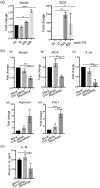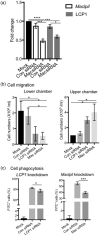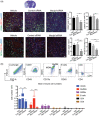Silencing the lncRNA Maclpil in pro-inflammatory macrophages attenuates acute experimental ischemic stroke via LCP1 in mice
- PMID: 30895879
- PMCID: PMC7168792
- DOI: 10.1177/0271678X19836118
Silencing the lncRNA Maclpil in pro-inflammatory macrophages attenuates acute experimental ischemic stroke via LCP1 in mice
Abstract
Long noncoding RNAs (lncRNA) expression profiles change in the ischemic brain after stroke, but their roles in specific cell types after stroke have not been studied. We tested the hypothesis that lncRNA modulates brain injury by altering macrophage functions. Using RNA deep sequencing, we identified 73 lncRNAs that were differentially expressed in monocyte-derived macrophages (MoDMs) and microglia-derived macrophages (MiDMs) isolated in the ischemic brain three days after stroke. Among these, the lncRNA, GM15628, is highly expressed in pro-inflammatory MoDMs but not in MiDMs, and are functionally related to its neighbor gene, lymphocyte cytosolic protein 1 (LCP1), which plays a role in maintaining cell shape and cell migration. We termed this lncRNA as
Keywords: Inflammatory; Ischemic stroke; lncRNA; macrophages; neuroinflammation.
Figures





Similar articles
-
LCP1 knockdown in monocyte-derived macrophages: mitigating ischemic brain injury and shaping immune cell signaling and metabolism.Theranostics. 2024 Jan 1;14(1):159-175. doi: 10.7150/thno.88678. eCollection 2024. Theranostics. 2024. PMID: 38164159 Free PMC article.
-
Systemically Silencing Long Non-coding RNAs Maclpil With Short Interfering RNA Nanoparticles Alleviates Experimental Ischemic Stroke by Promoting Macrophage Apoptosis and Anti-inflammatory Activation.Front Cardiovasc Med. 2022 May 6;9:876087. doi: 10.3389/fcvm.2022.876087. eCollection 2022. Front Cardiovasc Med. 2022. PMID: 35600488 Free PMC article.
-
Sult2b1 deficiency exacerbates ischemic stroke by promoting pro-inflammatory macrophage polarization in mice.Theranostics. 2021 Nov 1;11(20):10074-10090. doi: 10.7150/thno.61646. eCollection 2021. Theranostics. 2021. PMID: 34815805 Free PMC article.
-
Long Noncoding RNAs in the Pathophysiology of Ischemic Stroke.Neuromolecular Med. 2019 Dec;21(4):474-483. doi: 10.1007/s12017-019-08542-w. Epub 2019 May 22. Neuromolecular Med. 2019. PMID: 31119646 Review.
-
Microglia and Monocytes/Macrophages Polarization Reveal Novel Therapeutic Mechanism against Stroke.Int J Mol Sci. 2017 Oct 13;18(10):2135. doi: 10.3390/ijms18102135. Int J Mol Sci. 2017. PMID: 29027964 Free PMC article. Review.
Cited by
-
The Changes of Leukocytes in Brain and Blood After Intracerebral Hemorrhage.Front Immunol. 2021 Feb 15;12:617163. doi: 10.3389/fimmu.2021.617163. eCollection 2021. Front Immunol. 2021. PMID: 33659003 Free PMC article.
-
Transient Focal Ischemia Significantly Alters the m6A Epitranscriptomic Tagging of RNAs in the Brain.Stroke. 2019 Oct;50(10):2912-2921. doi: 10.1161/STROKEAHA.119.026433. Epub 2019 Aug 22. Stroke. 2019. PMID: 31436138 Free PMC article.
-
Immunological Landscape of Retinal Ischemia-Reperfusion Injury: Insights into Resident and Peripheral Immune Cell Responses.Aging Dis. 2024 Mar 1;16(1):115-36. doi: 10.14336/AD.2024.0129. Online ahead of print. Aging Dis. 2024. PMID: 38502592 Free PMC article. Review.
-
Systemic Characterization of the Gut Microbiota Profile after Single Mild Ischemic Stroke and Recurrent Stroke in Mice.Biomedicines. 2024 Jan 16;12(1):195. doi: 10.3390/biomedicines12010195. Biomedicines. 2024. PMID: 38255299 Free PMC article.
-
Effect of pretreatment with Devil's Claw on locomotor activity, infarct volume, and neuronal density in focal cerebral ischemia in rats.Avicenna J Phytomed. 2024 Jul-Aug;14(4):485-495. doi: 10.22038/AJP.2024.24294. Avicenna J Phytomed. 2024. PMID: 38952772 Free PMC article.
References
-
- Mozaffarian D, Benjamin EJ, Go AS, et al.Heart disease and stroke statistics – 2015 update: a report from the American Heart Association. Circulation 2015; 131: e29–322. - PubMed
-
- Menon BK, Saver JL, Goyal M, et al.Trends in endovascular therapy and clinical outcomes within the nationwide Get With The Guidelines-Stroke registry. Stroke 2015; 46: 989–995. - PubMed
Publication types
MeSH terms
Substances
Grants and funding
LinkOut - more resources
Full Text Sources
Other Literature Sources
Medical
Research Materials
Miscellaneous

